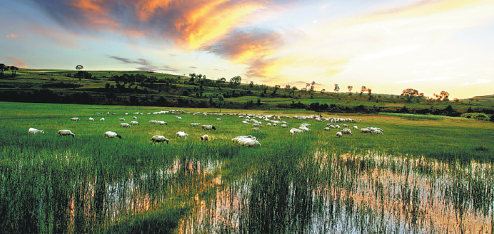Wetlands protection transforming Shanxi
Updated: 2023-07-21

The Cangtou River National Wetland Park is an epitome of Youyu county's efforts in environmental protection. [Photo by He Chaoshan for China Daily]
Sustainable development and wide-ranging government plans highlight unique features of area's natural habitats and biodiversity
With average annual precipitation of about 500 millimeters, Shanxi is by no means a humid region. However, this is not a province short of wetlands, especially in recent years.
Wetland areas are one of the most productive ecosystems on the planet, playing a crucial role in environmental protection, biodiversity and the well-being of humans.
Latest statistics show that Shanxi is home to more than 220,000 hectares of wetlands, accounting for about 1.4 percent of its land area and covering rivers, lakes, forest swamps, shrub swamps, swamp meadows, mud flats and marshes.
The wetlands in Shanxi are a gift from nature, especially along the Yellow River, its tributaries within the province and other rivers flowing to Bohai Bay. On the other hand, Shanxi's efforts in environmental protection are another reason contributing to the sustained growth of wetlands in recent years.
In Youyu at the northwestern tip of Shanxi, an establishment called Cangtou River National Wetland Park, which features lush forests, grass and meandering streams and brooks, counters the area's reputation as the most arid county in the province.
The park was added to the national wetland list in January 2021, as an endorsement of the county's decades of efforts in environmental protection.
Youyu used to be a drought-plagued landmass where the living conditions of residents were threatened by sandstorms. Back in the 1940s and 1950s, the greening rate there was only about 0.3 percent.
In the early 1950s, the local government began to implement a greening campaign to improve the ecological environment. Since then, government officials, together with forestry technicians and workers, as well as local farmers, have spared no effort in planting trees.
Over the past seven decades, more than 110,000 hectares of trees have been planted in the county, bringing its forest coverage to about 57 percent at this time. Now the previously barren land has been converted to an "oasis along the Great Wall", said a local official.
The official added that the increase in vegetation coverage has resulted in a steady increase of runoff volume of rivers, leading to the formation of the wetland park in Youyu.
Today, the Cangtou River National Wetland Park has become not only a major tourist destination in Youyu, but also an ideal habitat for birds and other animals. Local bird watchers reported that rare birds such as the Mandarin duck, pond heron and great bustard have been spotted.
Throughout Shanxi, the province is home to 63 wetland parks, including 20 national and 43 provincial wetland parks, as well as three wetland-based nature reserves, according to Wang Zhanqin, chief of the Shanxi Service Center for Nature Reserves.
He said that wetlands are a fragile ecosystem with growth subject to both changes of natural conditions and human activities.
He noted that reclaiming farmlands from wetlands and pollution caused by industrial and household sewage discharge used to be the major challenges to Shanxi's wetland ecosystem over the past century.
But these challenges have been properly addressed as the province has embarked on a path of sustainable development that highlights both growth and environmental protection since the 1990s.
"Our efforts in controlling pollution, returning farmlands to wetlands, increasing water supply and growing wetland vegetation have led to a fundamental improvement of the wetland ecosystem," Wang said. "This features the steady increase of wetland area and vegetation coverage, improved water quality and increased biodiversity."
The Shanxi Provincial Regulation on the Protection of Wetlands took effect on June 1, marking a new milestone for wetland protection in the framework of the rule of law.
Wang said Shanxi's next-stage efforts will include expanding the wetland network through scientific planning, and making the wetlands important venues for environmental protection, biodiversity development, scientific research, education and tourism.
The Gucheng National Wetland Park in the city of Yuncheng was the first national wetland park in Shanxi thanks to local authorities' unremitting efforts in helping the ecological recovery of the area.
"During the period from 2018-20, we returned more than 860 hectares of farmlands nearby to the wetland park," said Lu Dapeng, head of the Gucheng wetland park. "Most of the farmlands were located at the riparian zone of the Xiaolangdi Reservoir, which is the core area of the wetland park."
Xiaolangdi is one of the largest reservoirs along the Yellow River. The wetland park centering on the reservoir has a total area of more than 2,900 hectares.
Zhang Minshe is a nearby resident and a bird protection worker in the park. He said he is happy to see increasing numbers of birds and tourists to this park.
"Thousands of birds can be spotted during the migratory seasons, showing the marked improvement of the ecological environment," Zhang said. "These are also peak seasons for birdwatching tours."
Authorities in Shanxi are also using various occasions and local resources to help the public increase their awareness of wetland protection.
For instance, the local forest and grassland administrations are trying to promote wetland protection through campaigns centering on the World Wetlands Day, which falls on Feb 2 every year; and the Shanxi Birds-Loving Week in early April.
The wetland parks throughout Shanxi have organized educational and research tours for students to help them understand the wetland ecosystem and the importance of wetland protection.
The Qinhe River Source National Wetland Park in the city of Changzhi is one such destination.
"The park has an educational center for students, allowing them to learn about the formation and development of wetlands in Shanxi and China through multimedia means," said Dong Chao, an official at the wetland park. "Our monitoring center and the animal and plant specimen lab are also open to the students, giving them an idea on water-quality monitoring and biodiversity."
Zhang Liyuan contributed to this story.



